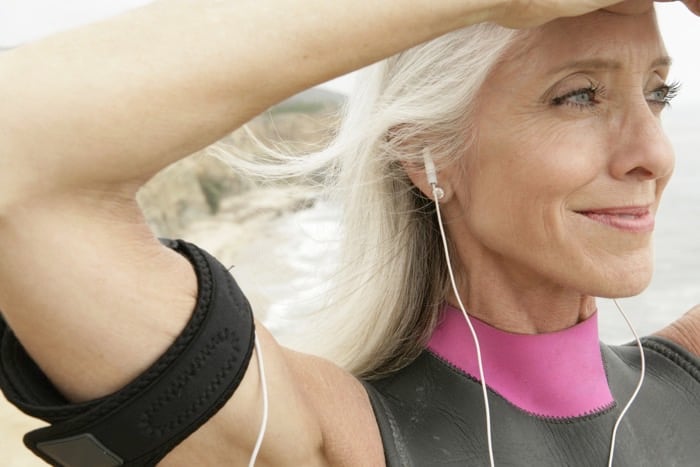 Running is a safe, healthy exercise for people of any age. More than 50% of the runners in the New York City Marathon are over 40. At age 52, Hal Higdon, marathon runner and writer, ran a 10km in 31:08 and a marathon in 2:29:27.
Running is a safe, healthy exercise for people of any age. More than 50% of the runners in the New York City Marathon are over 40. At age 52, Hal Higdon, marathon runner and writer, ran a 10km in 31:08 and a marathon in 2:29:27.
Effects of Age On Performance
Of course, aging does affect running performance. As we age, physical changes in the average person’s body occur. Aerobic capacity decreases, muscle mass, muscle elasticity and lung elasticity decline. Aging affects bone density, the metabolism and the immune system. The drop in aerobic capacity, reduced stride length, reduced leg strength, and reduced ability to store energy all contribute to a decline in performance.
One of the chief problems with older athletes is overconfidence. With these changes in the body, goals may need to be adjusted. You can calculate your age-grading here.
12 Tips For Training
Whether you’ve been running all along, picking up after quite an interval, or just beginning, it is wise to consider the following:
- Setting goals is an excellent way to stay focused and motivated. When establishing your goals, try using the SMART principle: Specific, Measurable, Attainable, Relevant, and Timely.
Try downloading a training app to your phone. These apps are helpful when setting goals and can usually tell you if your goals are too ambitious or too low for your current fitness level.
- Listen to your body. If you’re not fully recovered from a run, don’t force yourself. Running every other day, rather than 6 days a week might be the perfect regimen for you. Plan at least 2 rest days per week. Those days off can be used in cross training—cycling, swimming, or maybe yoga.
While it is hard work putting in all the training time for a marathon, remember you are doing it for the joy of running and sense of accomplishment.
- Regular strength training benefits all runners, but is more important for older runners. As we age, we lose muscle mass. Strength training can help stop this natural erosion and avoid the decline in muscle mass. Strong muscles absorb more impact in running, easing the stress on joints.
- Balance is a key factor in aging, and, of course, is significant to runners. Balance can be improved by using certain yoga moves, for instance the tree pose, king dancer and eagle pose. When you're ready to begin balance exercises, try weight shifts:
- Stand with your feet hip-width apart and your weight equally distributed on both legs (A).
- Shift your weight to your right side, then lift your left foot off the floor (B).
- Hold the position as long as you can maintain good form, up to 30 seconds.
- A thorough warm up and drinking enough liquids are key factors for older athletes.
- Everyone has bad days. They pass quickly, and the next workout is often. So, stick with the program.
- Reduce the amount of anaerobic training (exerting yourself over several minutes). For optimum fitness and health, load the body in moderation to the anaerobic threshold.
- Stay Motivated! If you’re taking up running at an older age, it may not come easily. Keep in mind why you’re doing this—for fun and for your health. Particularly, don’t forget the FUN part.
Find your motivation from a group. Join a marathon-training group. As you get closer to the marathon and hit your milestones, it can be difficult to maintain the level of training necessary to prepare your body for the event. Groups that are training for the marathon are a fun and easy way to train for the event and find your motivation.
There are many training and tracking apps available as well online and on mobile devices. Monitor your progress and share with your friends or training group
- Last but not least: Consider an annual sports medical check-up, to avoid risks, including an EKG under load, blood pressure check under load and a blood test. A heart ultra sonic test is advisable.
Your Muscles Can Still Get Stronger!
Don’t be quick to dismiss your ability to increase your muscular strength, flexibility and stamina. With smart training adjustments and a good attitude, you can do it!
Make sure that training includes your diaphragm. Remember, as you age you lose muscle mass. Your respiratory muscles are no different. Without exercising them regularly they will decrease in strength and elasticity resulting in shallower breaths.
PowerLung can help improve your breathing and improve your performance!
If respiratory muscles tire, oxygen is redirected to the muscles of your diaphragm to keep you breathing. This autonomic response robs the other muscles used in running of oxygen. A respiratory training program is the key to stronger respiratory capacity.
A study at the University of Technology, Sydney (Watsford et al., 2008), in which participants underwent a respiratory training program with an assisted respiratory device (PowerLung), found improvement in respiratory muscle strength. Of equal importance, the participants in the respiratory training program also noticed their breathing was not negatively impacting their activities because they were less breathless.
If you experience shortness of breath while running, consider an easy 5-minute PowerLung regimen twice a day. The results will amaze you.

